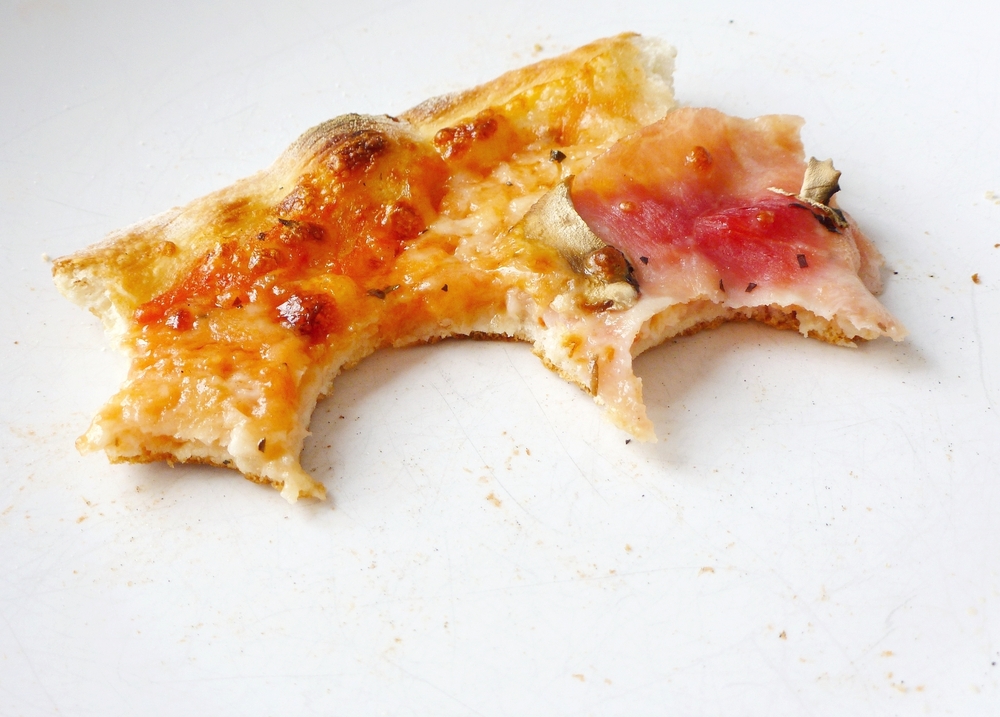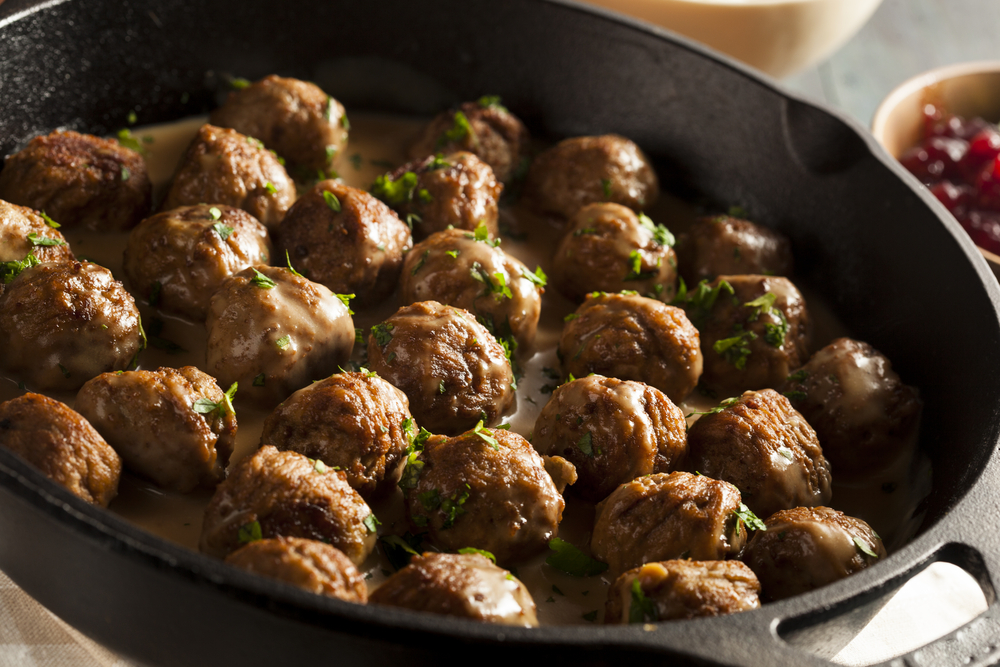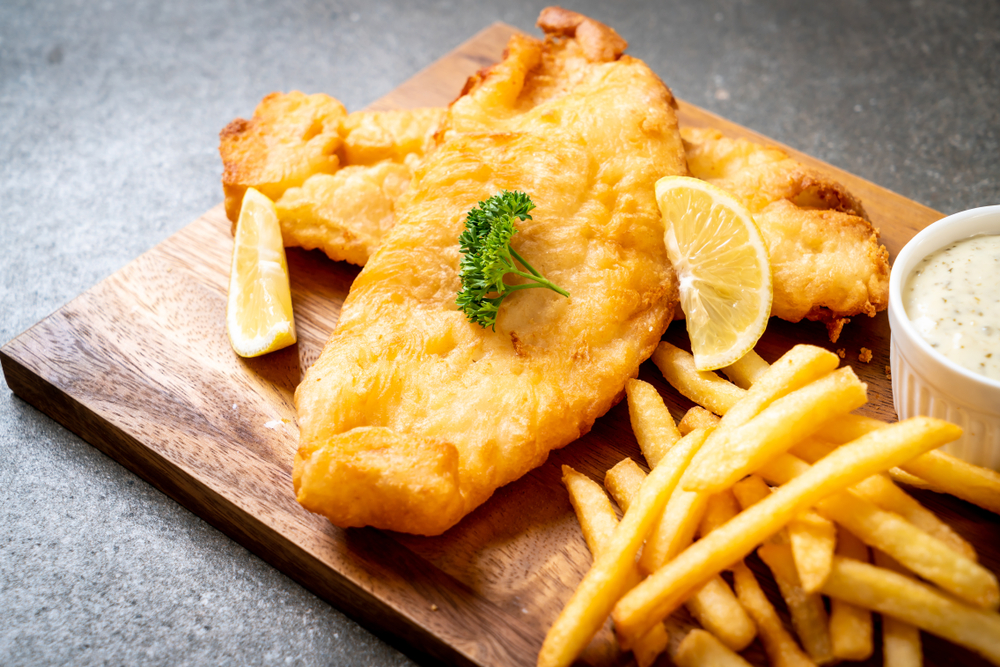I love a good stir fry, but sometimes I make too much and have leftovers. Reheating stir fry can be tricky because you want to retain the flavors and textures of the original dish.
In this article, I will share my tips and tricks on how to reheat stir fry so that it tastes as good as freshly made.
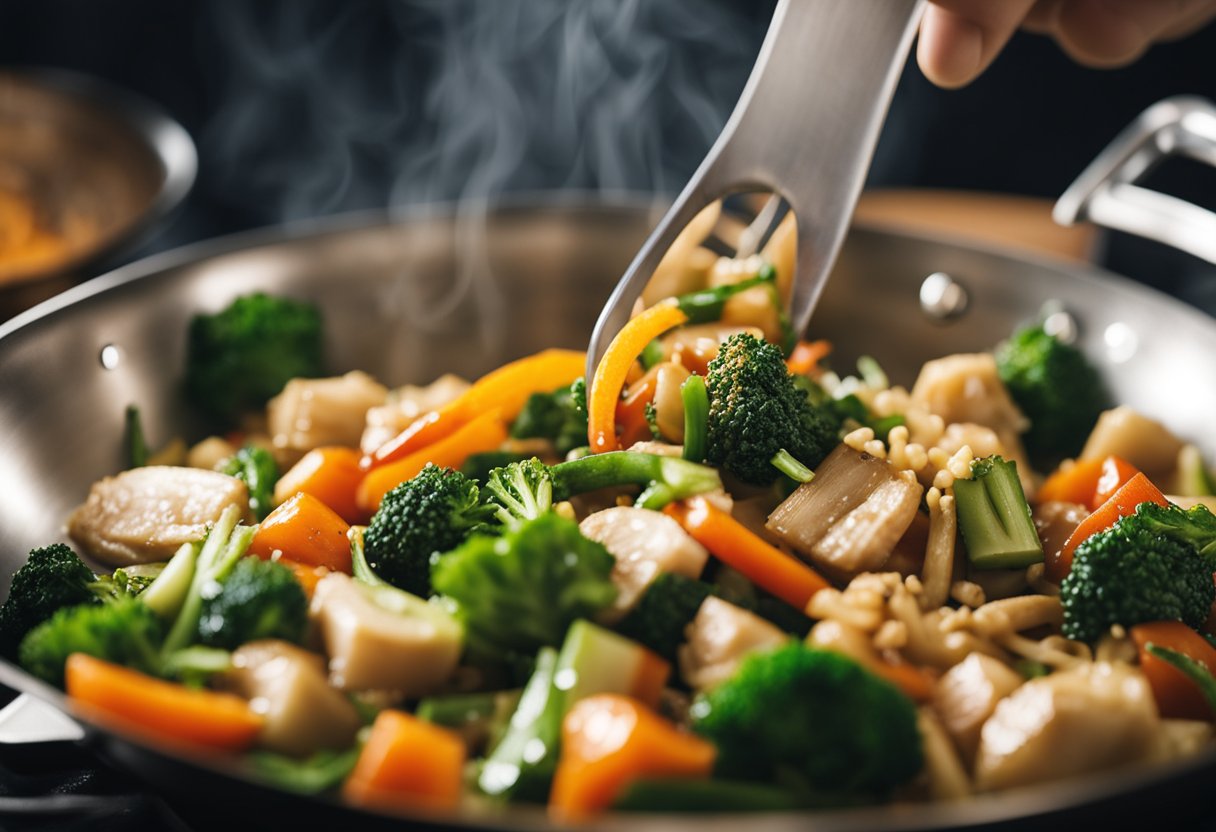
Before we dive into the specifics of reheating stir fry, it’s important to understand some basics. First, you want to make sure that you store your leftover stir fry properly. Store it in an airtight container in the refrigerator for up to three days.
Second, you want to avoid overcooking the stir fry when reheating it. Overcooking can lead to mushy vegetables and dry meat. With these basics in mind, let’s move on to preparing and reheating your stir fry.
To prepare your stir fry for reheating, remove it from the refrigerator and let it sit at room temperature for about 30 minutes. This will help it heat up more evenly.
Next, you want to separate any large clumps of food and break them up into smaller pieces. This will help the stir fry heat up faster and more evenly. Now that you’ve prepared your stir fry, let’s move on to the reheating methods.
Key Takeaways
- Properly store your leftover stir fry in an airtight container in the refrigerator for up to three days.
- Avoid overcooking the stir fry when reheating it to prevent mushy vegetables and dry meat.
- To prepare your stir fry for reheating, let it sit at room temperature for 30 minutes and break up any large clumps of food.
Understanding Stir Fry Reheating Basics
As a stir fry enthusiast, I know firsthand that reheating stir fry can be a tricky task. The key to successfully reheating stir fry is to retain the flavor and texture of the dish.
In this section, I will discuss the importance of texture and flavor retention and selecting the right reheating method.
Importance of Texture and Flavor Retention
Stir fry dishes are known for their unique texture and flavor. When reheating stir fry, it is important to retain these qualities.
The texture of stir fry can be affected by the reheating method used. For example, microwaving stir fry can make it soggy and unappetizing. On the other hand, reheating stir fry on the stovetop can help maintain its crispness.
The flavor of stir fry can also be affected by the reheating method used. Certain methods, such as microwaving, can cause the dish to lose its flavor. To ensure that the flavor is retained, it is important to use the right reheating method.
Selecting the Right Reheating Method
There are several methods that can be used to reheat stir fry. The method you choose will depend on the quality and taste you want to achieve.
Here are some of the most common reheating methods:
- Stovetop: This is the best method for retaining the texture and flavor of stir fry. To reheat on the stovetop, heat a skillet over medium-high heat, add a tablespoon of oil, and then add the leftover stir fry. Saute for about five minutes or until heated through.
- Oven: Reheating stir fry in the oven can help maintain its texture. Preheat the oven to 350°F, spread the stir fry out in a baking dish, and cover it with foil. Bake for 10-15 minutes or until heated through.
- Microwave: This is the quickest and easiest method, but it can cause the dish to lose its texture and flavor. To reheat in the microwave, transfer the stir fry to a microwave-safe dish and cover it with a lid or paper towel. Heat on high for 1-2 minutes or until heated through.
By selecting the right reheating method, you can ensure that your stir fry retains its texture and flavor.
Preparing Stir Fry for Reheating
As someone who enjoys cooking, I understand the importance of preserving the quality of my food, especially when it comes to reheating leftovers. Stir fry is a delicious and healthy meal that can be easily prepared in advance and reheated for later consumption.
However, it is important to prepare stir fry properly for reheating to ensure that it maintains its quality and taste. In this section, I will share some tips and tricks for preparing stir fry for reheating.
Storing Leftovers Properly
Storing your stir fry leftovers properly is crucial for maintaining its quality. To store stir fry, transfer it to an airtight container and place it in the refrigerator.
Make sure that the container is not overcrowded and that the lid is tightly sealed to prevent moisture from escaping. Proper storage will help to retain the flavor and texture of your stir fry.
Pre-Reheating Tips and Tricks
Before reheating your stir fry, there are a few things you can do to ensure that it reheats evenly and maintains its moisture. Here are some tips and tricks:
- Remove any excess oil or sauce from the stir fry before storing it. This will prevent the stir fry from becoming too oily or soggy when reheated.
- Add a small amount of water or broth to the stir fry before reheating it. This will help to create steam and prevent the stir fry from drying out.
- If you are reheating stir fry in the microwave, cover it with a damp paper towel to prevent moisture from escaping.
By following these tips and tricks, you can ensure that your stir fry reheats evenly and maintains its quality. In the next section, I will share some methods for reheating stir fry.
Reheating Stir Fry on the Stovetop
When it comes to reheating stir fry, using a skillet or wok on the stovetop is an excellent option. Here are some tips on how to do it properly.
Using a Skillet or Wok
Using a skillet or wok is a great way to reheat stir fry on the stovetop. If you have a non-stick skillet, it’s an excellent option. You can also use a cast iron skillet or a wok if you have one.
To start, heat your skillet or wok over high heat. Once it’s hot, add a small amount of oil. Vegetable oil or sesame oil is a great option.
Managing Heat and Oil
It’s essential to manage the heat and oil when reheating stir fry on the stovetop. If the heat is too low, the stir fry won’t heat up evenly, and if it’s too high, it can burn.
It’s also important not to use too much oil. Too much oil can make the stir fry greasy and unhealthy. A small amount of oil is all you need.
To reheat the stir fry, add it to the skillet or wok and stir for a few minutes until it’s heated through. You can also add a small amount of water or broth to help create steam and prevent the stir fry from drying out.
In conclusion, reheating stir fry on the stovetop is an excellent option. Using a skillet or wok and managing the heat and oil are key to getting it right. With these tips, you can enjoy your leftover stir fry as if it were freshly made.
Microwave Reheating Technique
How to Reheat Stir Fry in the Microwave
When it comes to reheating stir fry, the microwave method is the quickest and easiest way to go. However, it’s important to do it correctly to avoid sogginess and overcooking. Here’s how to reheat stir fry in the microwave:
- Transfer the stir fry to a microwave-safe dish or container. Make sure the dish or container is large enough to hold the stir fry without overcrowding it.
- Cover the dish or container with a microwave-safe lid or plastic wrap. This will help trap the steam and prevent the stir fry from drying out.
- Set the microwave power level between 50-70%. Lowering the power level allows for more even heating and prevents your stir fry from becoming overcooked or rubbery.
- Microwave the stir fry for 1-2 minutes, depending on the amount of stir fry you are reheating. Stop and stir the stir fry every 30 seconds to ensure even heating.
- Once the stir fry is heated through, remove it from the microwave and let it sit for a minute or two before serving.
Avoiding Sogginess and Overcooking
To avoid sogginess and overcooking when reheating stir fry in the microwave, keep the following tips in mind:
- Don’t overcrowd the dish or container. Overcrowding can lead to uneven heating and sogginess.
- Use a microwave-safe dish or container. Non-microwave-safe containers can leach harmful chemicals into your food or even catch fire.
- Use a lid or plastic wrap to trap the steam. This will help prevent the stir fry from drying out and becoming tough.
- Lower the power level to 50-70%. This will allow for more even heating and prevent overcooking.
By following these tips, you can reheat your stir fry in the microwave without sacrificing its flavor or texture.
Alternative Reheating Methods
If you don’t have access to a stovetop or microwave, there are other ways to reheat your stir fry. Here are two alternative methods that you can try:
Using an Oven or Air Fryer
If you have an oven or air fryer, you can use it to reheat your stir fry. Preheat your oven or air fryer to 350°F. Then, transfer your stir fry to an oven-safe dish or air fryer basket.
Cover the dish or basket with aluminum foil or air fryer parchment paper. Place the dish or basket in the preheated oven or air fryer and cook for 10-15 minutes or until heated through.
Reheating Noodles and Rice Separately
If you have leftover stir fry noodles and rice, it’s best to reheat them separately. To reheat stir fry noodles, cook them in boiling water for 30-60 seconds or until heated through. Drain the noodles and toss them with a little bit of oil to prevent them from sticking together.
To reheat rice, transfer it to a microwave-safe dish and cover it with a damp paper towel. Microwave the rice on high for 1-2 minutes or until heated through.
Keep in mind that the oven and air fryer methods may not work as well as the stovetop or microwave methods. Additionally, reheating noodles and rice separately may take more time and effort, but it can help prevent your stir fry from becoming soggy or overcooked.
Frequently Asked Questions
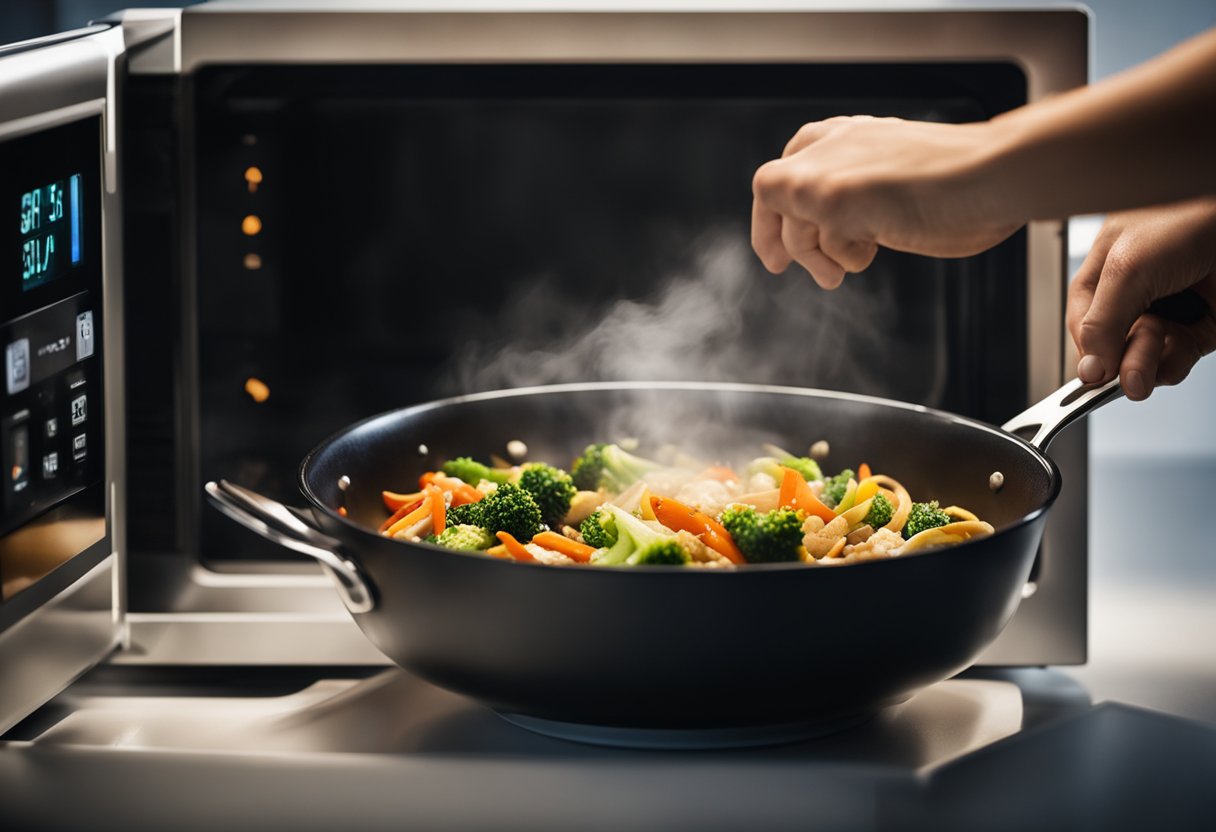
What is the best method to reheat stir-fried vegetables to maintain their texture?
The best method to reheat stir-fried vegetables is to use a wok or a skillet. This will help to maintain the texture and flavor of the vegetables. Start by heating the wok or skillet over medium-high heat. Once it is hot, add a small amount of oil and the vegetables.
Stir-fry the vegetables for 2-3 minutes until they are heated through. Avoid overcooking the vegetables, as this can make them mushy.
What are the steps for safely reheating chicken stir-fry in the microwave?
To safely reheat chicken stir-fry in the microwave, start by placing the leftovers in a microwave-safe container. Add a small amount of water or chicken broth to the container to help create steam.
Cover the container with a lid or microwave-safe wrap, leaving a small vent to allow steam to escape. Microwave the chicken stir-fry on high for 2-3 minutes, stirring occasionally, until it is heated through.
How can you reheat stir-fry rice to keep it moist and flavorful?
To reheat stir-fry rice and keep it moist and flavorful, start by adding a small amount of water or chicken broth to the rice. Cover the container with a lid or microwave-safe wrap, leaving a small vent to allow steam to escape.
Microwave the rice on high for 1-2 minutes, stirring occasionally, until it is heated through. Alternatively, you can reheat the rice in a skillet with a small amount of oil over medium-high heat.
Is it safe to eat leftover stir-fry cold, and are there any considerations?
It is safe to eat leftover stir-fry cold, but there are a few considerations to keep in mind. First, make sure the stir-fry has been stored properly in the refrigerator and has not been left out at room temperature for more than 2 hours.
Second, cold stir-fry may not be as flavorful as when it is heated, so consider adding a small amount of soy sauce or other seasonings to enhance the flavor.
What is the recommended time and power level for reheating beef stir-fry in the microwave?
The recommended time and power level for reheating beef stir-fry in the microwave will vary depending on the amount of leftovers and the microwave wattage.
As a general rule, start by reheating the beef stir-fry on high for 1-2 minutes, stirring occasionally, until it is heated through. If it is not heated through, continue microwaving in 30-second intervals until it reaches the desired temperature.
How long can leftover stir-fry be stored in the refrigerator before it is no longer safe to consume?
Leftover stir-fry can be stored in the refrigerator for up to 4 days before it is no longer safe to consume. Make sure to store the leftovers in an airtight container and label it with the date it was stored.
If you are not sure if the stir-fry is still safe to eat, use your senses to check for any signs of spoilage, such as an off odor, mold, or slimy texture.




